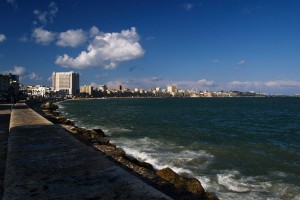Researchers from the University of Alexandria have developed a cheaper, simpler and potentially cleaner way to turn seawater into drinking water than conventional methods. This could have a huge impact on rural areas of the Middle East and North Africa, where access to clean water is a pressing issue if social stability and economic development is to improve. Right now, desalinating seawater is the only viable way to provide water to growing populations, and large desalination plants are now a fact of life in Egypt and other Middle Eastern countries. Most of these plants rely on a multi-step process based on reverse osmosis, which requires expensive infrastructure and large amounts of electricity. These plants release large quantities of highly concentrated salt water and other pollutants back into the seas and oceans as part of the desalination process, creating problems for marine environments. That’s why the race is on to find a cheaper, cleaner and more energy-efficient way of desalinating sea water.
Researchers Mona Naim, Mahmoud Elewa, Ahmed El-Shafei and Abeer Moneer announced that they have developed a new way to purify sea water using materials that can be manufactured easily and cheaply in most countries, and a method that does not rely on electricity. The technology uses a method of separating liquids and solids called pervaporation.
Pervaporation is a simple, two-step process, the first step involves filtering the liquid through a ceramic or polymeric membrane, while the second step requires vaporizing and collecting the condensed water. Pervaporation is faster, cleaner and more energy efficient than conventional methods, not least because the heat required for the vaporization stage does not necessarily have to be electrically generated. Pervaporation is not new, it has been in use for many years but the membrane used in step one has been expensive and complicated to manufacture.
The breakthrough in this research is the invention of a new salt-attracting membrane embedded with cellulose acetate powder for use in step one of the pervaporation process. Cellulose acetate powder is a fiber derived from wood pulp and is, according to the researchers, cheap, easy to make in any laboratory and is produced in Egypt. The powder, in combination with other components, binds the salt particles as they pass through, making the technique useful for desalinating seawater. “The membrane we fabricated can easily be made in any laboratory using cheap ingredients, which makes it an excellent option for developing countries.” This powder works along with other components to suck the salt particles from the dirty water and allow the clean water to pass through.
The membrane can quickly desalinate highly concentrated seawater and purify even badly contaminated seawater. It can also be used to capture pollutants and salt crystals to minimize pollution of the environment. The membrane can be used in very remote situations using fire to vaporize the water. The second phase of the process involves heating the desalinated water until it vaporizes. The water vapors are then condensed to remove impurities, and clean water is extracted. This technique could be very useful for desalinating seawater. This technique offers a significant cost reduction from existing energy-sucking desalinization techniques like reverse osmosis.The membrane technology in combination with vaporization can be applied in remote settings, as it requires only the membranes for the filtering process, and fire to vaporize the filtered water, the researchers say. “Using pervaporation eliminates the need for electricity that is used in classic desalination processes, thus cutting costs significantly,” says El-Shafei. The technology can be adapted for commercial use by fabricating larger sheets of the membrane and cutting these into suitable swathes, according to El-Shafei. The next step for the team is to establish a small desalination unit as a pilot project for the technology. Researchers have yet to prove the commercial viability of the product, but if they can, it could be a promising alternative for developing countries where water and electricity is a scarce resource.
For more information please visit: www.phys.org


Comments are closed.